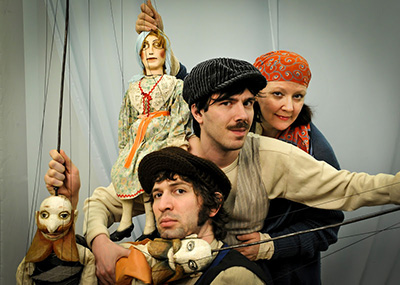
What was it like when the Nazis were in Poland and Polish Jews were in hiding, in fear for their lives? What was it like for simple village Peasants, before the Nazis invaded Poland & occupied everywhere?
Tadeusz Nowak’s 1968 novel, “A Jak Krolem a Jak Katem Bedzies,” has been charmingly transformed into a marionette ppic by Vit Horejs for his Czech-American Marionette Theater.
This distinctive ensemble performs in a tradition long known to the socialist countries of Eastern Europe. The animated and involved puppet handlers (in full view of the spectators) are laughing, singing, crying, dying and dancing with their tiny-to-giant marionettes. To American audiences brought up on “Star Trek” & James Bond, it can be an historic tonic to be transported backward into a peasant world most of us cannot even imagine (unless, of course, Fiddler on the Roof speaks to you).
Speaking of that, there’s also live Klezmeresque music to accompany the life journey of poor peasant Piotr, who eventually, when he joins the Polish resistance against the hated German invaders, has to kill two collaborators, who are local men he’s known all his life.
World War II now seems a long way past for those of us who lived through it, but for younger audiences, it can be cautionary to discover how things were in Eastern Europe at that time.
King Executioner offers three rear-lit panorama monitors on which scenes and backgrounds of the developing narrative appear. These are in a striking black-and-white visual style, so impressive, in fact, that it would be a show in itself to see all three panoramas unroll to Klezmer music.
The Czechoslovak American Marionette Theater’s admirable production of The Golem is even much farther back in time than King Executioner, so the past is not lost, even if we recover it with tiny dolls on rods and strings. The charm and detail with which the various Marionettes have been constructed and costumed is astonishing. It even takes four puppeteers to animate the Giant (one handler for each giant boot!).
